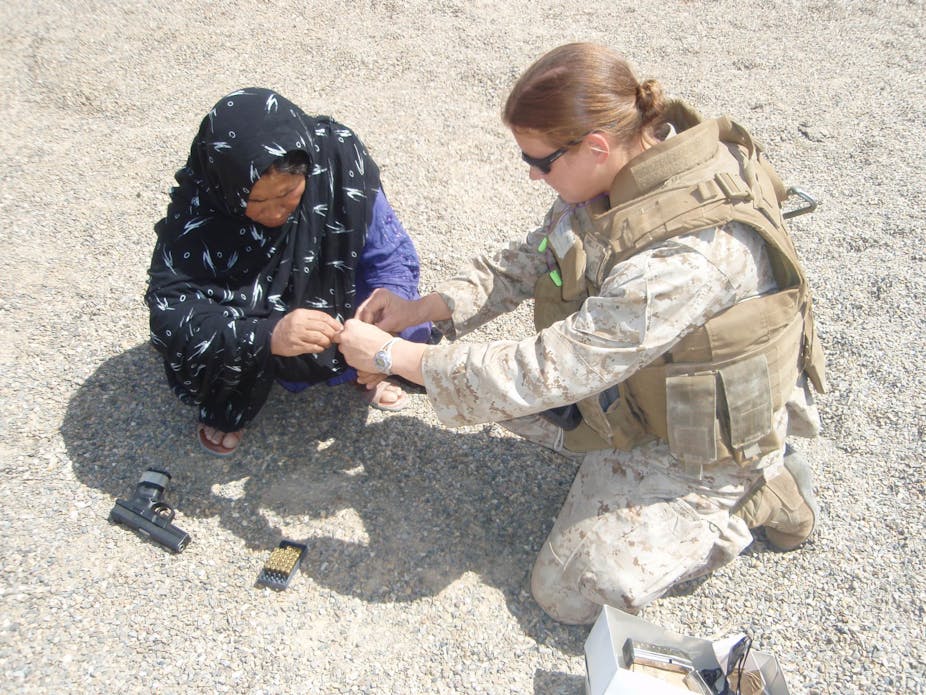As a member of the Royal Navy, I never really thought that being a woman affected my work. Whether I was making safety decisions about flying helicopters or participating in operational planning, my contribution was listened to and respected.
I wasn’t sidelined or disadvantaged for being a woman in a military largely populated by men. I was just one of the team.
I joined Britannia Royal Naval College straight from school so I grew up in the institution. As a young recruit, I knuckled down to basic training and got on with it, accepting the history and tradition we were presented with. It’s true that we were surrounded by men – as instructors, commanders and famous historical figures – but this seemed logical. I had joined a male dominated British organisation, so what did I expect?
I do recall a sense of wanting to hold my own with my male peers to demonstrate myself as capable. But otherwise, with the exception of differentiated fitness tests, it seemed rare that my gender had any serious relevance.
When it did come up, whether it was being jeered at by young sailors on a night out or having to wear uniform skirts (rather than trousers), it was something I just accepted as part of the lifestyle. The military runs on a bit of banter, and it really didn’t seem that bad. Anticipating the excitement of engineering in demanding environments, I just wanted to put my training into practice and get on with the job.
Looking back
Now that I am no longer in the navy, I have had the chance to think about my ten years of service from the outside. It has been a slow transition, but I have begun to notice the impact of a male-dominated hierarchy on military culture and the way it thinks about war.
When I think of subtle examples of this culture, I remember how at sea, we used to hang our drying underwear in lockable cages to prevent it from being stolen by male sailors. At the time, I just accepted this as what we did. Now I question why on earth it was our responsibility to keep our underwear away from the male sailors and not theirs to behave appropriately.
This might seem an insignificant example – but I think there is a connection here between the characteristics of military culture and the way people unquestioningly think about war as a male domain.
Six months working on civil-military operations in Afghanistan sparked my own interest and research into women as counterinsurgents. Counterinsurgency is a battle against guerilla warfare – and a fascinating case for considering gendered ideas of warfare.
It is often described as a battle for the hearts and minds of a population. And although there have been examples of coercive and abusive campaigns, counterinsurgency is a method which can have a strong, non-violent influence on a military operation.
To win over a population, you have to talk to them, not shoot them (albeit supported by targeted strikes). Conversation topics range from attempts to understand community dynamics, working to implement a small scale community improvement project or planning the delivery of programmes from the Afghan ministries of health, education or agriculture.

Through talking to local people, we aimed to win support both for the international military presence and the Afghan government. My own involvement was in helping to train Helmandi policewomen, working with female local officials or monitoring development initiatives specifically designed for women.
Counterinsurgency itself appears to have two sides battling against each other. It is either a bloody and aggressive battle against the enemy or a sensitive engagement with the population. Some have characterised the divide as a masculinised versus feminised counterinsurgency.
A woman’s place
So where do women fit into this gendered idea of counterinsurgency? During the influential British campaign in Malaya, an extensive self-help community outreach programme was coordinated by Lady Templer, the General’s wife, supported by the British Red Cross and Women’s Institute.
In Northern Ireland, female soldiers were employed on special duties as covert surveillance operators able to easily blend in with the community.
The British Army introduced women-led engagement teams to Afghanistan in 2010, using female soldiers to interact with the local population. It is unsurprising that these teams were largely discredited given that they had an ill-defined mission, against which it was hard to judge success or even objective.
There is a danger that gender-focused policies in war zones become tokenistic and rapidly forgotten. They risk failing simply because they run counter to the dominant masculinised campaigns, and the way we currently think about conflict.
But as the British military thinks about counterinsurgency in the post-Afghanistan era, there is surely an opportunity to embrace more enlightened ways of integrating gendered policies for contemporary operations – and to challenge how we think about what we want our soldiers to do, and how we train them to do it.

